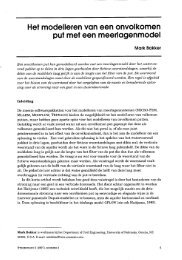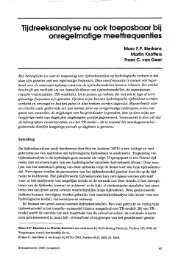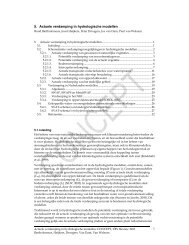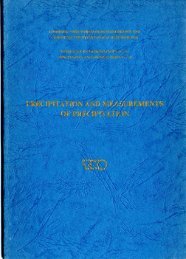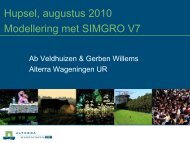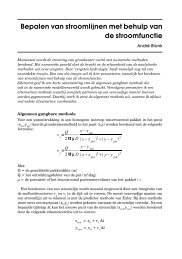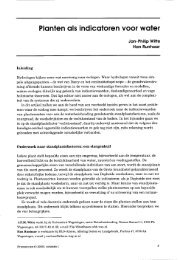- Page 1 and 2:
Netherlands organkation fw applied
- Page 4 and 5:
TNO Commlitee on Hydrological Resea
- Page 6 and 7:
2 RIVER WATER AM) THE QPALITH OF TB
- Page 8:
B.J.M. Baptist BIJkswaterstaat. Tid
- Page 11 and 12:
This approach will put to use what
- Page 13 and 14:
Estuaries that have not been influe
- Page 15 and 16:
2 CHIWGES XN TEE DELTA The Delta ar
- Page 17 and 18:
area decltned cnnside~ably, leadins
- Page 19 and 20:
Plan, then it is apparent tbt the s
- Page 21 and 22:
Tiddl flats df the Eastem Seheldt v
- Page 23 and 24:
tracefore possible to convert the a
- Page 25 and 26:
Figsrlre 7 Changes in the cadrnrum
- Page 27 and 28:
prevention measures are desirable h
- Page 29 and 30:
elationships between different spec
- Page 31 and 32:
Bio-essay Weriments with polluted s
- Page 33 and 34:
considerable thought to drawing up
- Page 35 and 36:
ShLOUONS, W. and BYSINK, W.D., 1981
- Page 37 and 38:
are taken. The first year after the
- Page 39 and 40:
The Hollands DiepJnaringpllet is pa
- Page 41 and 42:
In 1976 the determination of chlozo
- Page 43 and 44:
, 0.66 m 0,s - 0.02 1989 I 0.86 - 0
- Page 45 and 46:
Table 3 Eutrophication of the Volke
- Page 47 and 48:
Laks Volkarek ---- Lake Zoom 0.40 0
- Page 49 and 50:
4 WAGBEET MEdSIIRaS TO PEEVBT OR LT
- Page 51 and 52:
Table 5 gives estimtes of the phosp
- Page 53 and 54:
In principle, two states of equilib
- Page 55 and 56:
Zooplankton (Alma affinis) Pike (Es
- Page 58 and 59:
EUTROPHICATION OF ESTUAAIES AND BRA
- Page 60 and 61:
The average discharge of Xhine and
- Page 62 and 63:
and only l-2% cows frm the aive Sch
- Page 64 and 65:
highest trophic potential: nutrient
- Page 66 and 67:
period 1980-19$3 in an increase of
- Page 68 and 69:
model calculations reveal that a ni
- Page 70 and 71:
Table 3 PreUmInary carbon budget of
- Page 72 and 73:
Water life of Lake Grevelingen
- Page 74 and 75:
macrophytes livkg on or rooting in
- Page 76 and 77:
less predictable for water managers
- Page 78 and 79:
ILWNEWIJK, A.. KEIP, C., 1988. De v
- Page 80 and 81:
XBE CHANGING TmAL LAMXiCAPE I N TEE
- Page 82 and 83:
The storm surke of L&Z1 A.D., knorm
- Page 84 and 85:
osi* rn@8IOIP m .SL 4 Has F~~ULB 3
- Page 86 and 87:
During the 19th century man starts
- Page 88 and 89:
mudflats have retreated some 100-20
- Page 90 and 91:
aq811~33a.e~ pue 3pTatlJS uxaJsafi
- Page 92 and 93:
Erosion by waves of sandy shoals (c
- Page 94 and 95:
Lt has been estimated that the sedi
- Page 96 and 97:
Implementafion of the Delta Project
- Page 98 and 99:
ECOLOGICAL DEVELOWdENT OF SALT MAKS
- Page 100 and 101:
fn tidal water systems sedimentatio
- Page 102 and 103:
hierarchical position. Tn the egtua
- Page 104 and 105:
Of course. tke environmental change
- Page 106 and 107:
wind erasson, desaliuation, aeratio
- Page 108 and 109:
Fonner tirtal flats with saltmarsh
- Page 110 and 111:
Grevelingen. Lake Veere and Krammer
- Page 112 and 113:
As mentioned above aa important que
- Page 114 and 115: A seaond important perspective for
- Page 116: BEEEXNX, W.D. and 80ZBf&. J. L9M. T
- Page 119 and 120: are determining the dfstrlbution af
- Page 121 and 122: this volume or in Duutsaa, et aL, 1
- Page 123 and 124: artificial waterflow was created af
- Page 125 and 126: of waterbirds occur regulsrly. The
- Page 127 and 128: . DISTRIBUXIOBI OF WATEJBIRoS OVER
- Page 129 and 130: small bird$ extludiag them vill net
- Page 131 and 132: In order to lsok for relatiouehips
- Page 133 and 134: Table 3 Biomass of macroroobenthos
- Page 135 and 136: freshwater basins. Clearly the pres
- Page 137 and 138: scmthem bottueary o-f the winter di
- Page 139 and 140: OCLURRENCE AND DIET QF B ~T .tUQ 80
- Page 141 and 142: 5.2 H- factors Next to all fartors
- Page 143 and 144: Bewick's Swans (Cygnus columbariusl
- Page 145 and 146: m's activiries do not always have t
- Page 147 and 148: measure affecting food supply or av
- Page 149 and 150: DOQiWT$QS, G. 4 TWISK, F., 1987. De
- Page 151 and 152: MEININGEB, P.L. and HAPEREX, A.M.M.
- Page 153 and 154: PISCIVORES Litfle Grebe Great Crest
- Page 156 and 157: IPYBRO-EGOLOOIOAL BELATIONB ZN THE
- Page 158 and 159: apart from upstream purification; -
- Page 160 and 161: Storm surge barrier Eastern Scheldt
- Page 162 and 163: - In addition to existing managemen
- Page 166 and 167: Ro. 1. No. 2. SQ. 3. Investigations
- Page 168 and 169: 25. The relation between water quan





